-
Car Reviews
- All reviews
- Midsize SUVs
- Small cars
- Utes
- Small SUVs
- Large SUVs
- Large cars
- Sports SUVs
- Sports cars
- Vans
Latest reviews
- Car News
-
Car Comparisons
Latest comparisons
- Chasing Deals
With the Mitsubishi Triton’s ‘cheap ute’ status deliberately disregarded, does this new-gen 4×4 have what it takes to challenge Hilux and Ranger head on?
The outgoing fifth-generation Mitsubishi Triton, which first made its debut in 2015, was characterised by its reliability, affordability and being as tenacious as a one-eyed mountain goat when you took it off road.
Some fans might say this new-generation has big shoes to fill, but to Chasing Cars and many others, it’s a long overdue replacement. In truth, the outgoing Triton was lacking in a number of areas spanning from capability to liveability.
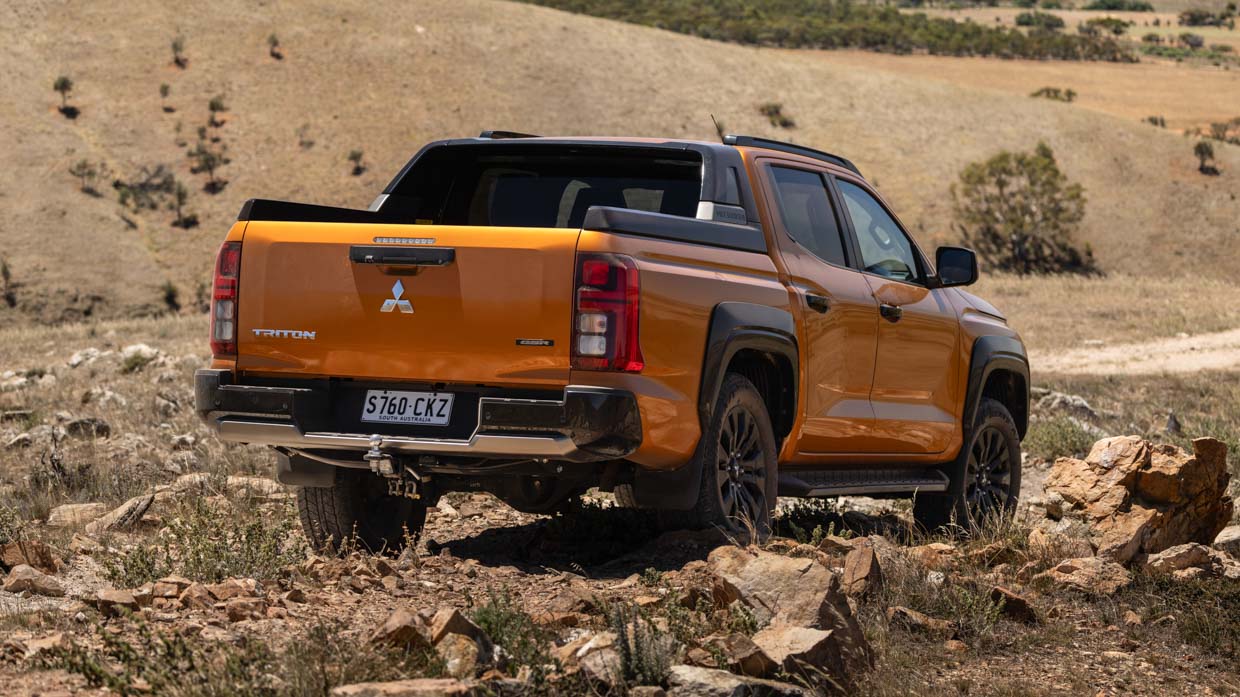
It was these factors which led to it being placed dead-last in our Dual-Cab Ute Megatest back in 2022, despite its impressive capabilities in select areas such as off-roading.
In a big deviation from its past identity, Mitsubishi Australia CEO Shaun Westcott told Chasing Cars the Triton was no longer a “cheap car”, a nameplate that once was focused on drawing in buyers at a low price.
Perhaps there is only way but up (market) for the Triton, in the face of new Chinese rivals such as the GWM Ute and LDV T60 Max, which have undercut the Mitsubishi significantly in price.
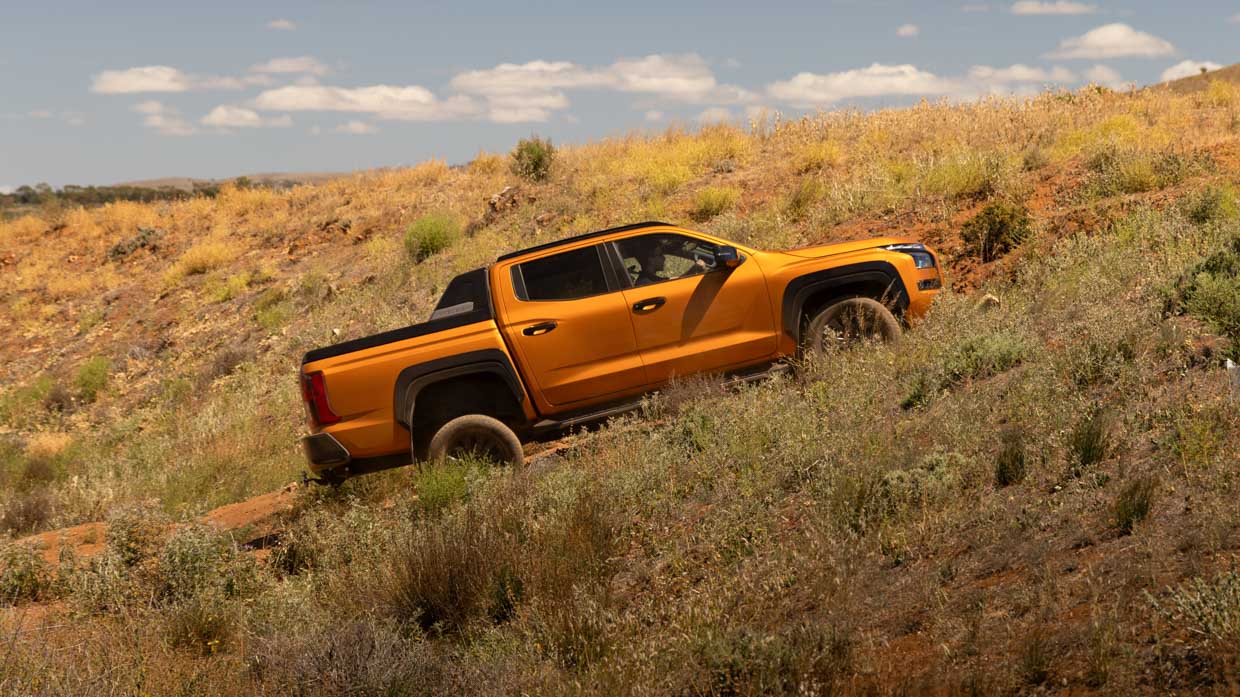
However, Westcott was blunt in his assessment that the Triton was now improved to such a degree that he would be “embarrassed” if it was compared to one of its Chinese rivals.
A comparison will have to wait for another day, but the good news is this new-generation vehicle is indeed a big step forward – from its improved 3.5-tonne towing capacity, bigger and better interior to its smooth twin-turbo 2.4-litre engine and improved safety equipment. There is a lot to like here.
It’s also a larger vehicle than before, growing to 5320mm (+15mm) in length, with an additional 130mm put into the wheelbase alone. The Triton has also followed rivals such as the Ford Ranger by widening its track by 50mm. Add a new, beefier chassis and all of these changes suggest this is a genuinely all-new Triton.
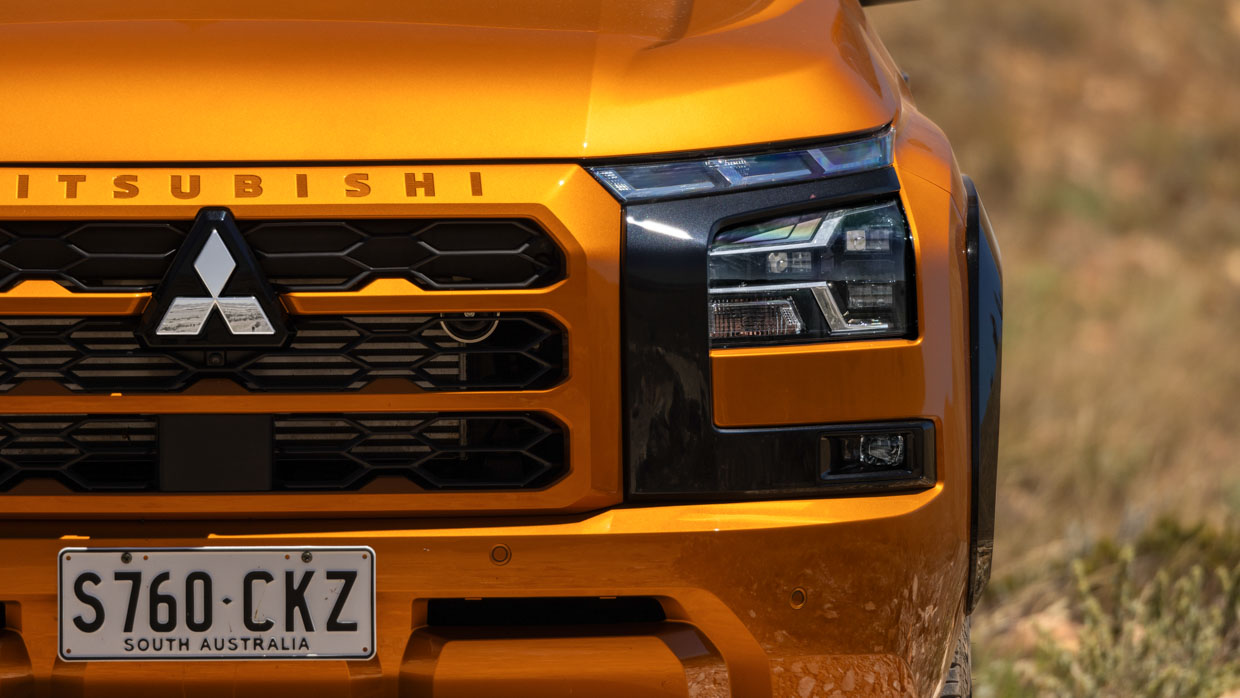
Right now, the only kind of Triton you can buy is the most popular dual-cab pick-up body style which makes up the vast majority of purchases in Australia.
Prices, specs and other details are yet to be released on the club cab, single cab and models equipped with a six-speed manual transmission, which are expected to follow when these are released later in 2024. This will likely present some more affordable options.
But for now, prices start from $43,690 before on-road costs for the 4×2 GLX, with the 4×4 version commanding a price of $50,940. The range tops out at $63,840 for the flagship GSR.

These prices reflect an increase of between $3250 and $7600 across the range, though Mitsubishi insists the Triton is still good value – and they might have a point.
Even the top-spec model is still a fair bit cheaper than its competition. If you want a Ford Ranger for similar coin, it will have to be the lower/mid grade Sport 2.0TT at $65,890 and the back-to-basics Toyota Hilux SR5 auto still costs $60,250.
So with its revised pricing and heavy arsenal of new claims and capability, has the Triton successfully taken things to the next level?
Like before, the Triton range is essentially split into two halves, with the entry-level GLX and GLX+ equipped with heavy-duty suspension and selectable 4WD, while the GLS and GSR feature a more comfort-leaning suspension setup paired with the brand’s famed Super Select ll 4WD system.
Starting with the GLX, the Triton includes:
Stepping up the to GLX+ adds:
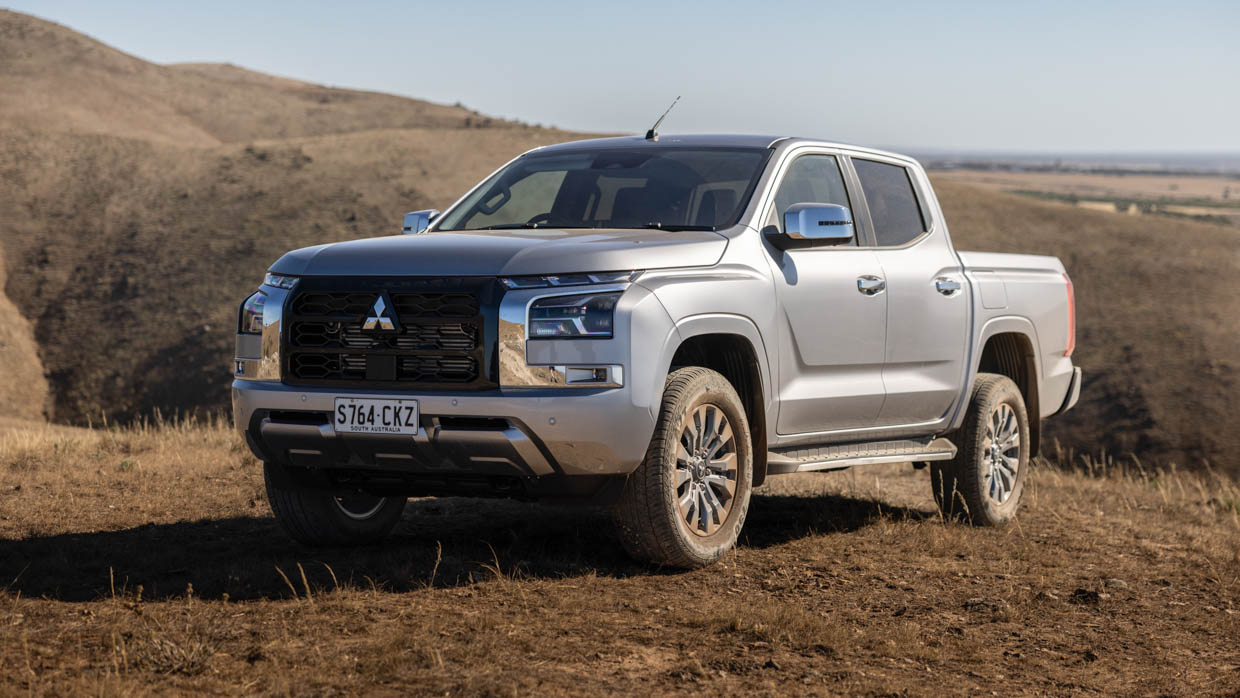
Pictured: the GLS grade
Above that, the GLS adds:
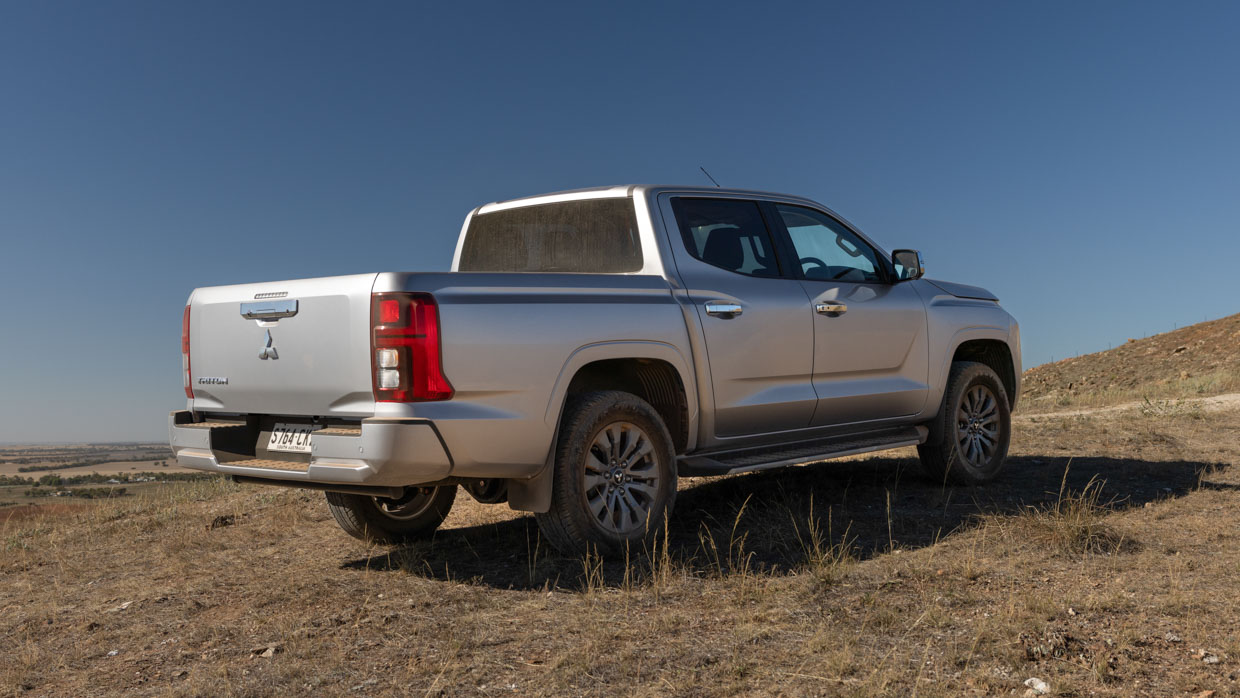
The GLS’ popular luxury pack – now known as the Leather Option – has returned and sees buyers net heating for the front seats, power adjustment for the driver and leather upholstery complete with silver stitching for an extra $1500.
Finally, the top-spec GSR adds the following features over the GLS.
The price of the Triton has gone up since its last generation, but so too has the standard level of specification.
Features like standard power lumbar support and a 360-degree camera across the range are impressive, so too is the fact all Tritons are fitted with the most powerful twin-turbo option when many entry-level utes carry a fairly uninspiring starting engine.
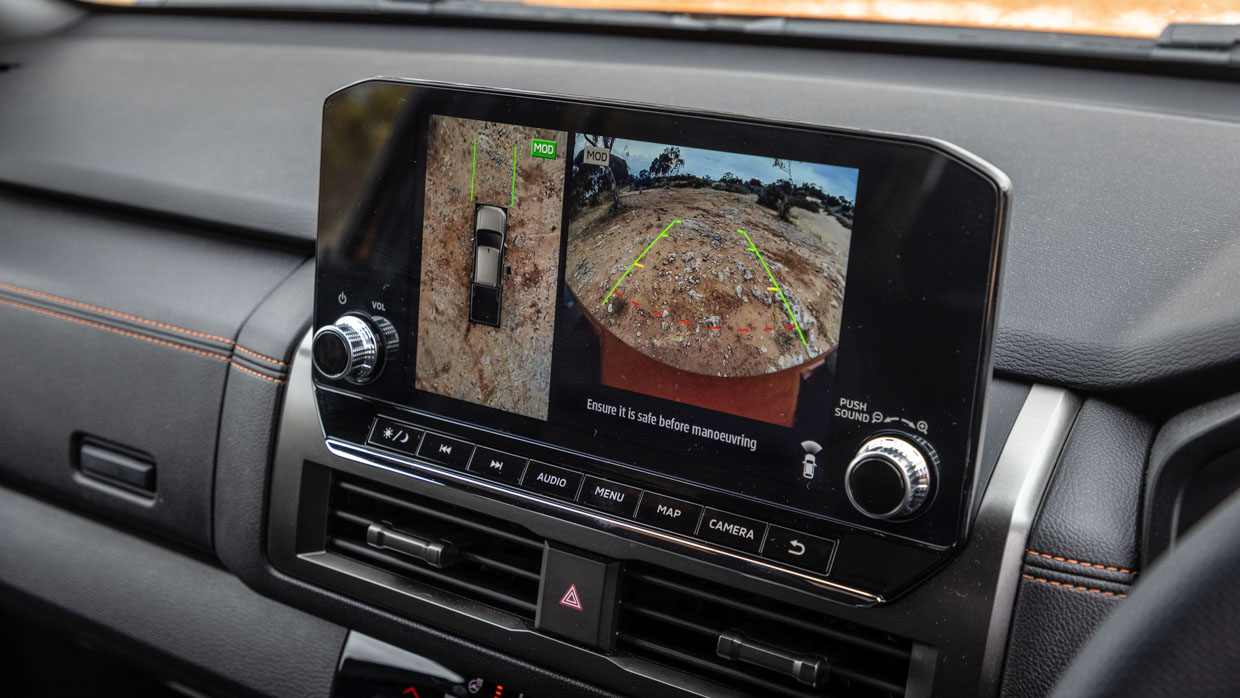
At the other end of the spectrum, the lack of passenger-side power seat adjustment on the GSR is odd for the top-spec grade and the multimedia screen is smaller than newer Ranger and Amarok rivals – but then again it’s also a lot cheaper.
Looking at the range overall and taking the bolstered safety equipment (detailed below) into account, the Triton has gained a lot in exchange for its price jump and, indeed, remains good value.
The sixth generation has improved its drivability in a number of areas but let’s start with the new 2.4-litre twin-turbo four-cylinder engine first.
While it shares the same displacement as the single-turbo, this is a new engine – one engineer joked to me that Mitsubishi “would have saved lots of money” if they would have simply strapped a second turbo to the old block and called it a day, but a new engine was required to hit all the performance and reliability benchmarks.

Power has increased by 17kW to 150kW at the same 3500rpm peak; while torque has benefited massively, jumping from 430Nm to 470Nm. But where the old engine had more of a torque ‘peak’ at 2500rpm, the new one has a ‘torque band’ from 1500rpm to 2750rpm.
The results are what you’d expect. The new 2.4L feels like it’s working a lot less hard, more of the time. The practical outcome is that the Triton has gone from being a vehicle which was moderately quick unladen but struggled under load to something that is downright sprightly, and I suspect would still be a far more competent tow vehicle.
With a distinct lack of noise from the more hushed engine, the new twin-turbo setup also feels far more refined, with none of that surging behaviour that comes from big-single turbo setups like you’ll find on the Isuzu D-Max.

In the name of keeping emissions down, Mitsubishi has fitted the Triton with a 17-litre AdBlue tank, with the large size chosen so that it can stretch to the 15,000km service intervals before it needs to be topped up.
Mitsubishi told Chasing Cars if the fluid does run out on a long drive the Triton will keep going until it’s switched off, at which point it will need a refill to start.
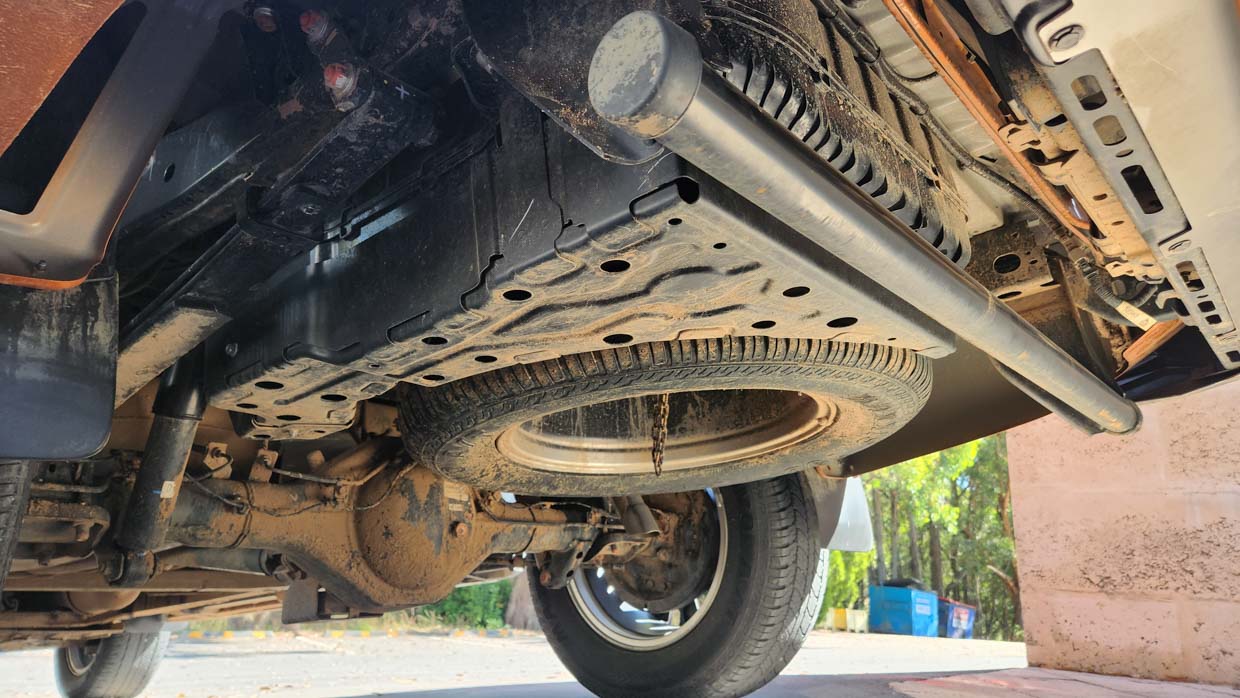
As before, the Triton is equipped with a six-speed automatic, which is a carryover from the old model but it’s not something that needed upgrading in my opinion. Mitsubishi says the eight-speed found in the Pajero Sport was considered but going for two-fewer cogs helped to keep prices down.
The Australian-developed steering and suspension tune is something that the team at Mitsubishi Motors Australia is very proud of, and something they had to fight for given that the original plan was to have one setup for the entire world.

The steering of the new Triton is pretty easy to like, it’s relatively forthcoming with feedback despite switching to an electric setup. The rack ratio is also a bit quicker than before.
Driving through a combination of city areas, fast mountain roads and across the choppy bitumen circling the Adelaide countryside, the Triton proved to be surprisingly competent and comfortable in a range of areas.
The suspension consists of double wishbones up the front, with shocks that are thicker in diameter while offering longer travel than before. At the rear, Mitsubishi has decreased the amount of leaves and fattened up those that remain to reduce unsprung mass.

With its wider track and significantly longer wheelbase, the Triton feels like a larger and more mature class of vehicle. It’s far less affected by poor road conditions and even larger bumps are dispatched with relative ease, keeping you on your intended driving line as a result.
In fact, the Triton proved to be remarkably – and surprisingly – agile when pushed hard, with the default 40:60 front and rear torque split of the Super Select ll system assisting in providing relatively stable drive.
The Super Select ll system retains the ability to lock the centre diff while on the move to give drivers a 50/50 torque split, which succeeded in providing a neutral balance on fast-flowing Aussie dirt roads.
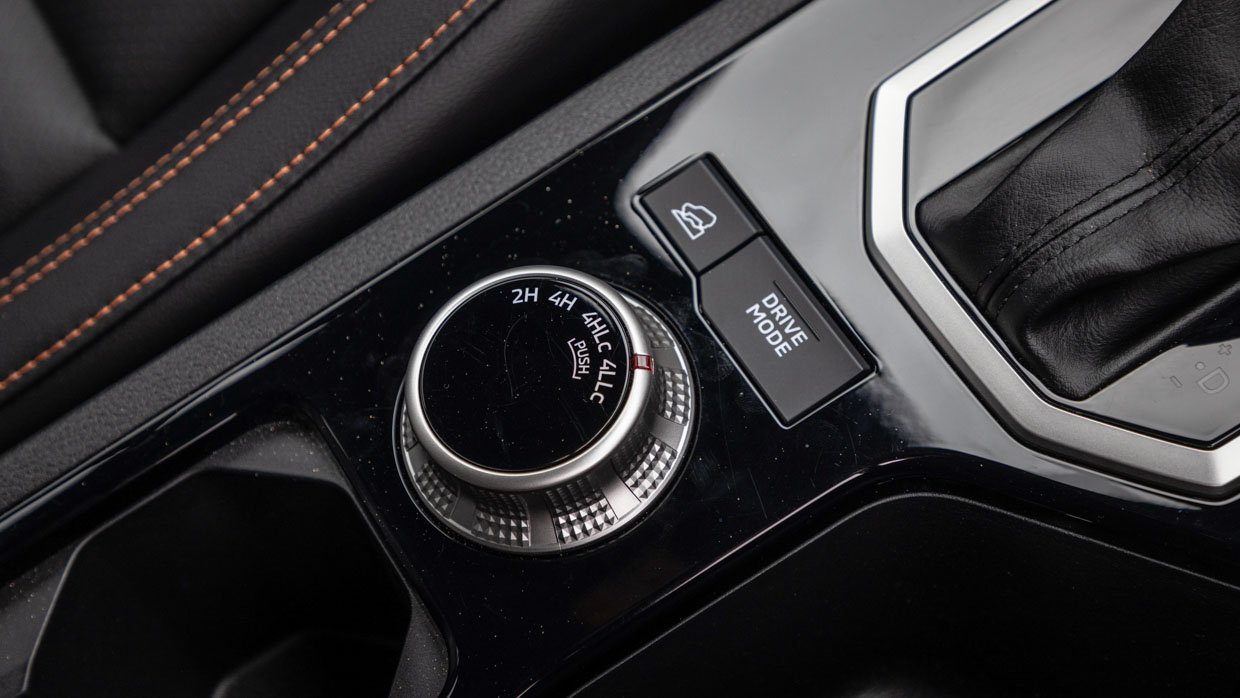
Full-time four-wheel-drive systems are the flavour of the month with utes, but Mitsubishi has been doing this for quite a while and it shows – they also happen to be the most affordable in the market. Yes, GWM Ute does offer a ‘set and forget’ setup of its own, but its system is on-demand rather than constantly engaged.
The one area the suspension does fall short is at low speeds, where a great deal of vibration was felt inside the cabin despite the road appearing relatively smooth. Of course, if the Triton was laden the jittery nature would likely be far more ironed out.

We’ll do more in-town evaluation of the ride quality in later reviews to try and nail down the problem specifically but the impression for now is that the Ranger and Amarok are more comfortable vehicles over a wider range of conditions.
Our experience here was sampled in the GLS and GSR grades with the more comfy suspension setup, though we did quickly snag some time in the GLX+, which has the ‘heavy duty’ option and found it to be roughly 10 to 20 percent harsher, though not devastatingly so.
If there was one area the Triton probably didn’t need to be improved, it was in off-road capability.
Despite placing last in our aforementioned 2022 ute comparison, the old Triton was easily one of the best of our tested field when it scaled rocky paths, ascended steep switchbacks and tackled awkward elevation.

The bad news is the Triton’s nimble-nature, which often proved to be of great advantage in these conditions, has been somewhat compromised in exchange for its larger proportions. It’s still an incredibly capable vehicle, just in slightly different ways.
Driving the old and new models back-to-back on a very dry and rocky track, the new Triton simply rolled over obstacles that the old fifth-gen would scamper up.
The latter might be more fun if you’re an enthusiast off-roader, but for the regular weekend warrior, the more measured approach it’s probably the wiser choice.
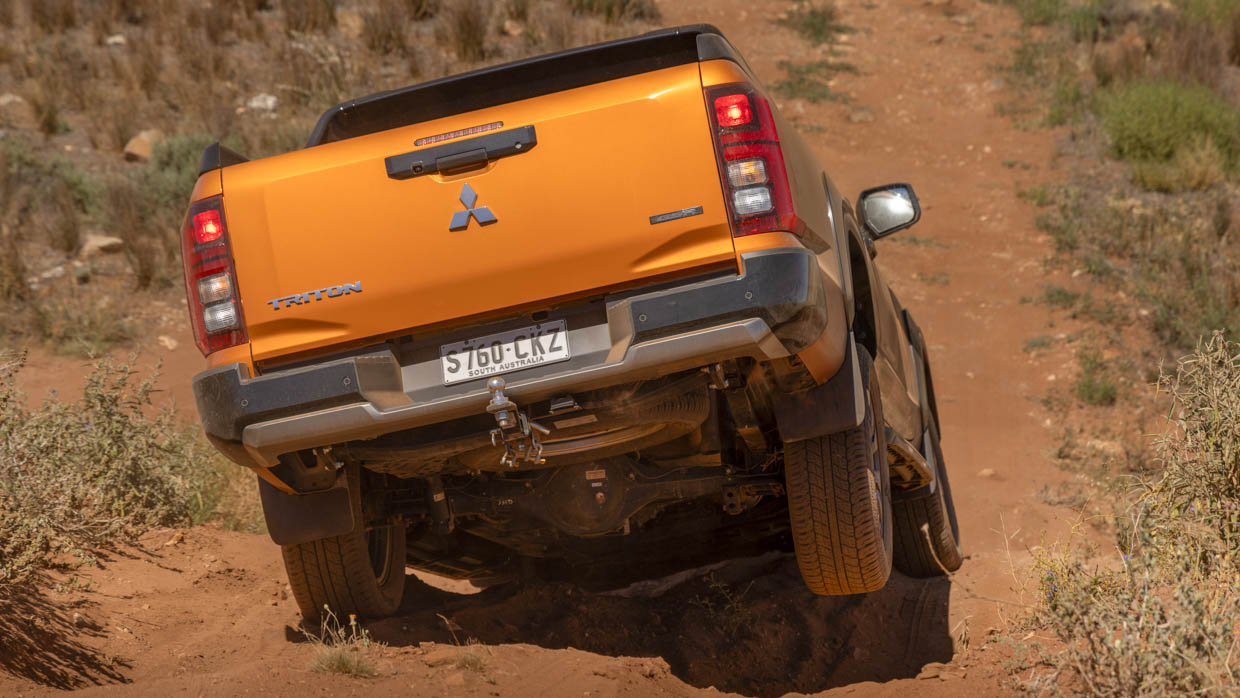
Part of the reason for this more relaxed demeanour is the increased amount of torque from a much lower base of 1500rpm, allowing drivers to better trace their path up a tricky climb without killing momentum, when the old single-turbo engine ran out of puff.
The traction control system remains remarkably keen, plus an expanded set of ‘drive modes’ for a variety of conditions such as sand and rocky surfaces make things even easier. A rear locker is found on most grades
You’ve likely heard much about the Triton’s upgrade to the almost industry standard ‘3.5-tonne’ braked towing capacity, but what’s more interesting is how much payload is left over when you take a look at its GCM versus its rivals.
As seen on the table below, when comparing the top-spec GSR against its rivals in grades which are either similar in price or intention, the Triton shows a pretty strong advantage. Note that the GWM and LDV are also limited to three-tonne towing.
| Mitsubishi Triton GSR | Ford Ranger Sport 2.0TT | Toyota Hilux SR5 | LDV T60 Max Luxe | GWM Ute Cannon-X | |
| GCM | 6250kg | 6350kg | 5850kg | 5900kg | 5555kg |
| GVM | 3200kg | 3230kg | 3050kg | 2900kg | 3150kg |
| Kerb weight | 2170kg | 2296kg | 2110kg | 2150kg | 2100kg |
| Towing capacity | 3500kg | 3500kg | 3500kg | 3000kg | 3000kg |
| Remaining payload | 580kg | 554kg | 240kg | 750kg | 455kg |
Of course, these figures don’t take into consideration things like accessories such as tow bars (you’ll probably need one of those), canopies, and everything else every Aussie ute buyer is almost certain to throw on their ute.
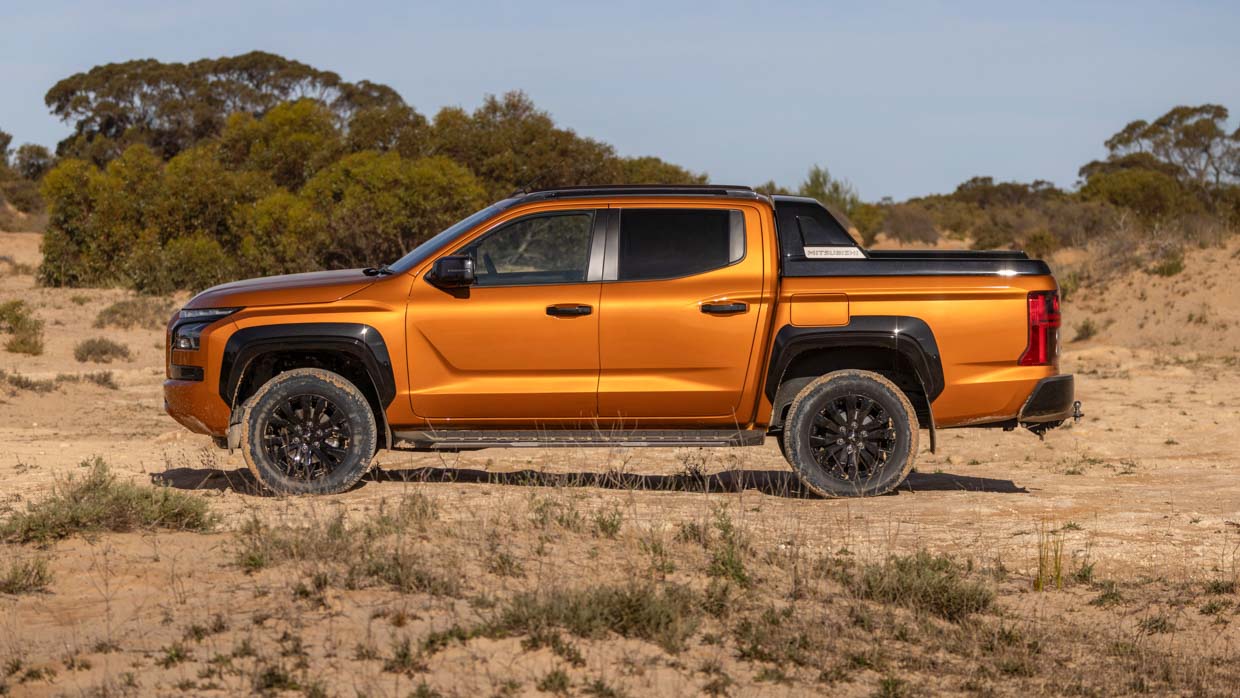
How the Triton actually performs with a 3.5-tonne load behind it still remains a matter for another day, but it’s nice to know you have more legal headroom to do so safely.
It should also be noted that the Triton has retained rear drum brakes, meaning its heat dissipation when underload could be inferior to rivals that have moved on to disc systems.
In terms of raw payload, it’s also worth noting that all dual-cab auto Tritons are true one-tonners, with the lowest rating being 1030kg for the uber-accessorised GSR.
If there is anywhere the Triton has benefited the most from its 50mm increase in width, it’s right here in the cabin.
Swapping from the old Triton to the new is the difference between some unpleasant touching of front occupant elbows to now actually having the room to spread out and relax on a long drive.
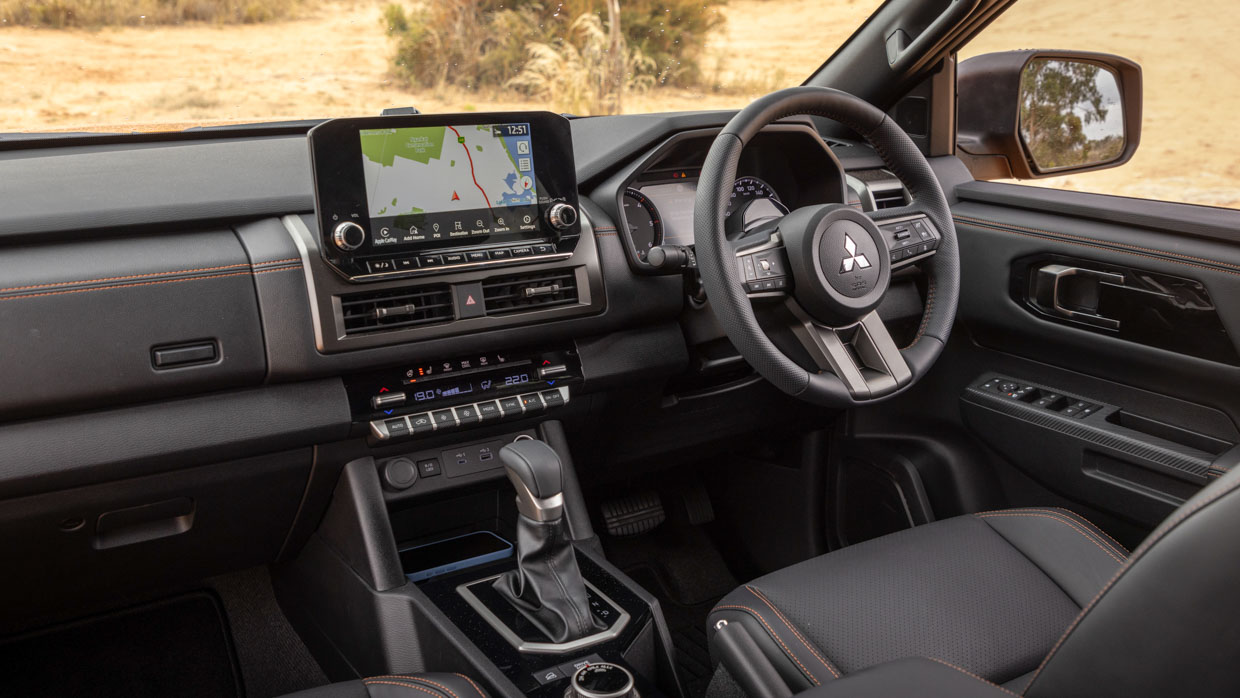
In person, the Triton’s interior design differentiates itself from the Outlander midsize SUV through the addition of a number of small changes to help it better serve as a commercial vehicle.
The cabin, particularly in the top-spec GSR, is a combination of soft surfaces, on areas such as the armrest and portions of the dashboard, and durable hard-plastic everywhere else. The door cards are a particularly notable example, with soft leather laying the inside and a surface along the top that’s probably hard enough to affix a clamp to.
The driver sits 20mm higher in the new Triton than in its predecessor, providing a slightly more commanding driving position and better visibility over the ute’s larger dimensions.
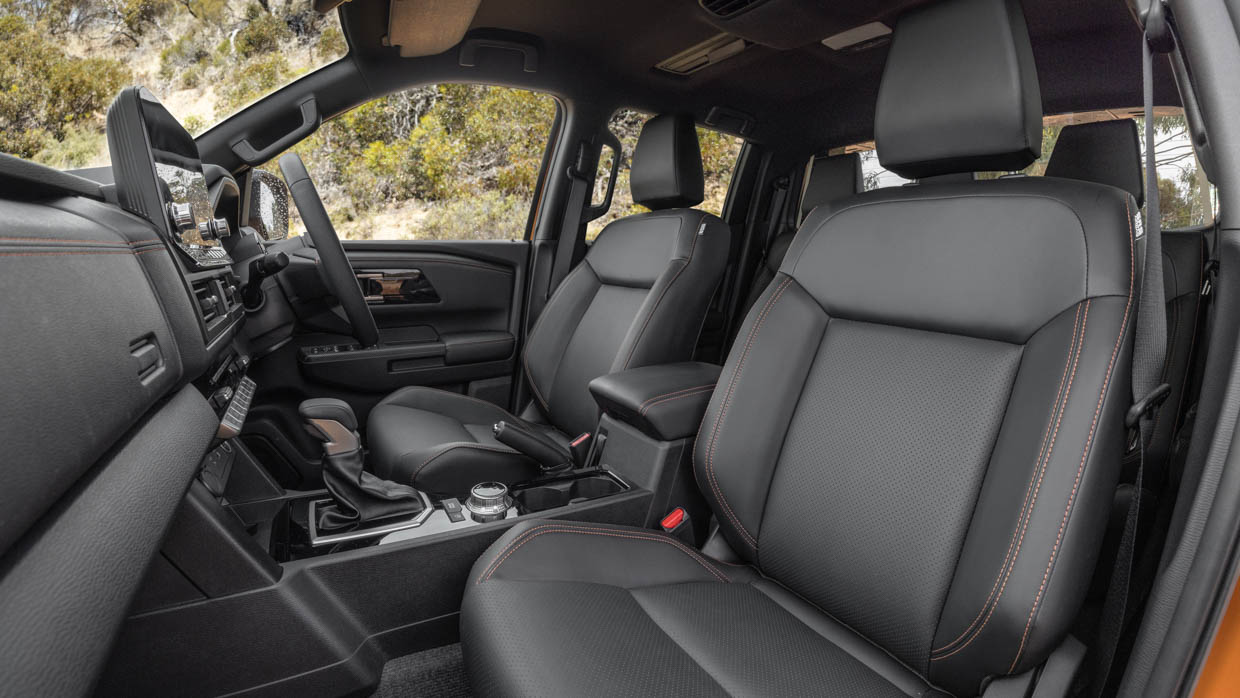
Seat comfort is much better this time around, with greater shape applied to support the driver’s thighs on long trips and the standard inclusion of adjustable lumbar support is fantastic for retaining proper posture and ultimately reducing fatigue.
A 9.0-inch touchscreen is offered throughout the range and features wireless Apple CarPlay but Android Auto is exclusively wired, unlike the format in some rivals. The screen itself is a good size though, and the slew of buttons around the frame and on the steering wheel provide a good amount of control without faffing about with the screen.
Mitsubishi said one of the goals with the Triton’s interior was that it could be used while wearing gloves and with the exception of a few multimedia functions the company has pulled it off. All the controls are large in size and the climate controls remain entirely physical, unlike the Volkswagen Amarok for example.

Many will be happy to hear that a manual handbrake has been retained, as has a large shifter that you can operate without thinking. The entire space feels durable, with the glaring exception of the slab of gloss black plastic across the centre console, which will surely be covered in micro scratches within days after purchase.
A 15-watt wireless charger sits in front of the shifter and is a great addition for a modern ute such as this and the fact that Mitsubishi has equipped both USB-A and -C ports, both of which can be used for phone mirroring, is a nice touch.
A colourful 7.0-inch digital display sits between two analogue dials and provides almost too much information and menu settings for the driver, but it’s there if you need it. Some rival utes are adopting full-width displays here, but there isn’t a huge difference in actual usability.
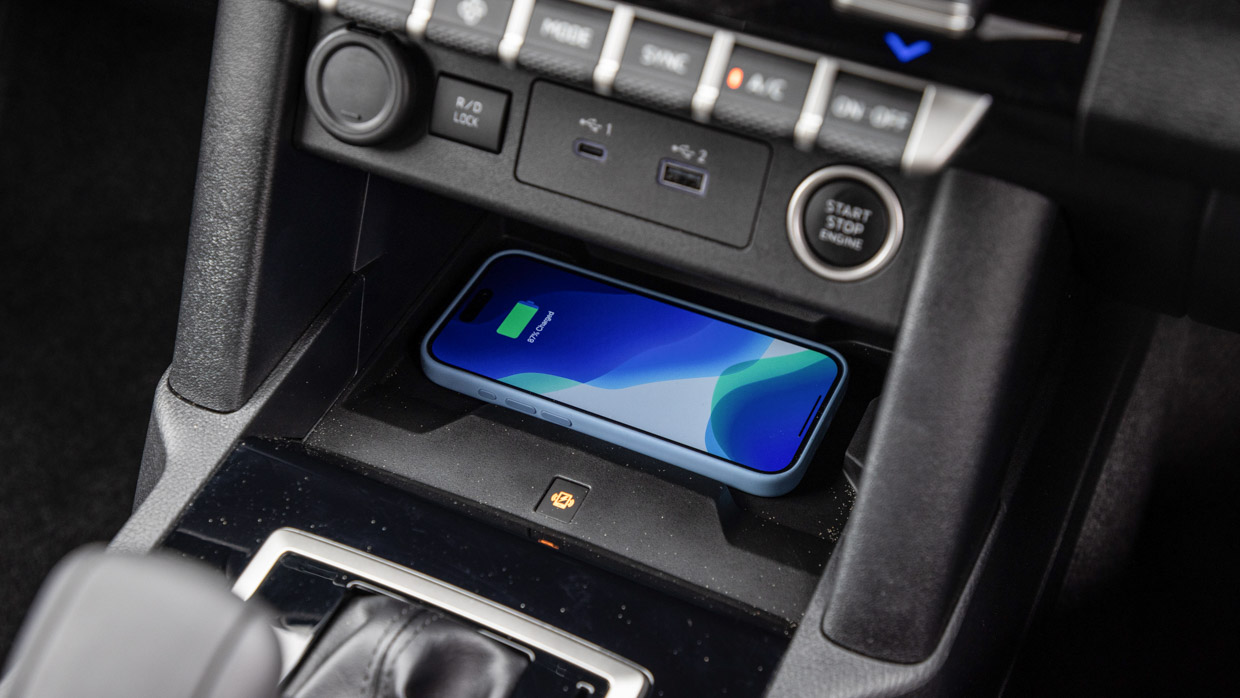
Storage is impressive in the Triton, with enough room to fit four 600ml bottles under the armrest and room for a 1.5L drink bottle in each of the doors.
Moving to the backseat, the room on offer is decent enough for a midsize dual-cab such as this with enough room for me to sit behind my own 182cm driving position.
The rear bench is less of an afterthought than the previous model, likely due to the increasing role of dual-cab utes as full-time family vehicles. The outboard seats have higher bolstering and the centre seat is wide enough to accommodate a third passenger.
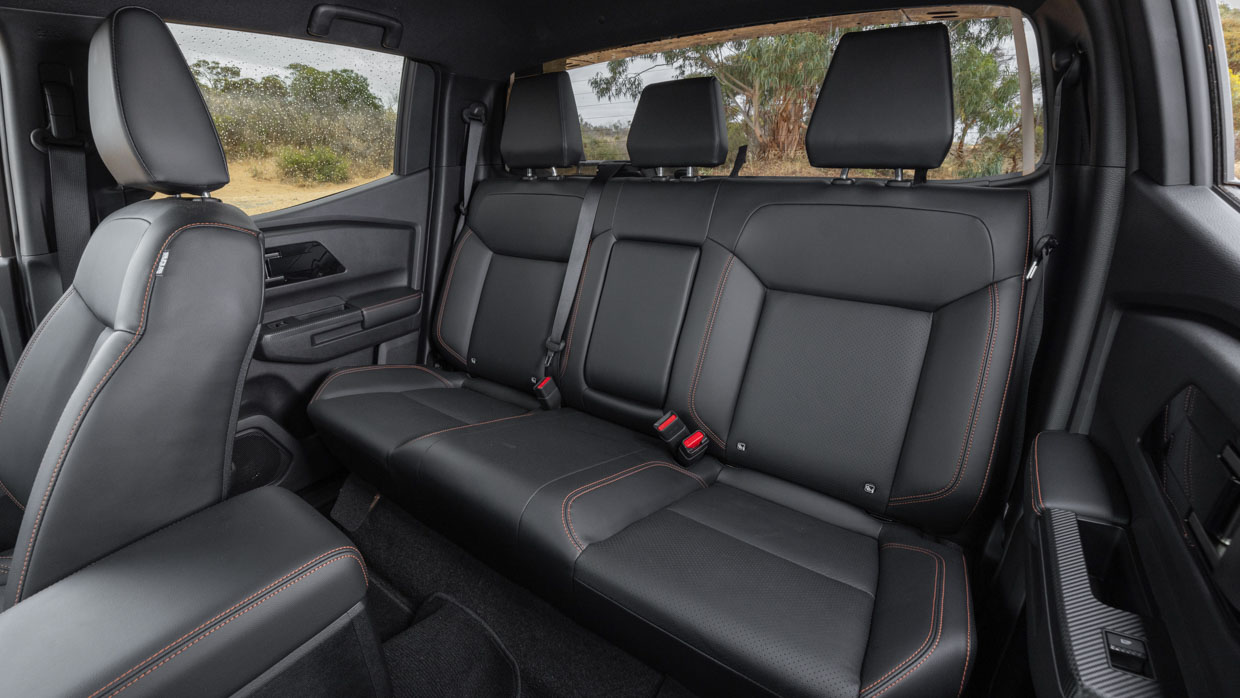
Like before, the Triton retains an air circulation pod mounted on the roof, rather traditional air vents mounted on the rear of the centre console as found in most cars, SUVs and utes.
Mitsubishi has keen to point out this was a deliberate choice, as although the roof-mounted system does not connect to the compressor directly, they argue it’s actually more effective at keeping the cabin temperature more consistent.
I’m not sure I entirely agree, but I also acknowledge that body-on-frame vehicles with their high floors often see your knees blocking centre-console mounted air vents anyway.
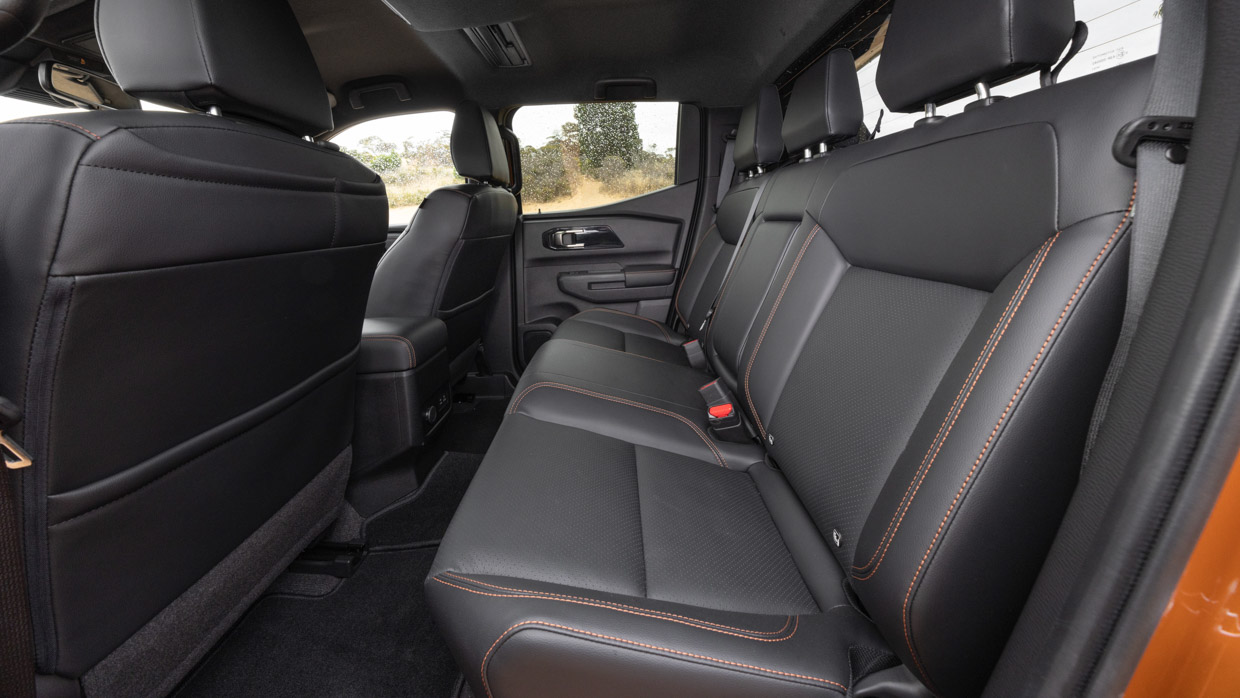
Finally, it’s worth noting that the rear seats don’t flip up like the Ford Ranger or Volkswagen Amarok, and they certainly don’t lift up in a 60/40 split like the Toyota Hilux, which is helpful for loading small- and medium-size loose items, such as shopping.
The tray of the Triton has grown in size as well and now joins a growing field of new-generation utes that are capable of fitting a 1200mm Euro pallet between the wheel arches, even when a tub liner is fitted.
The space itself is a bit bare though, there’s only four tie-down points to do ‘ute things’ and there’s no clever adjustable racking system like you’ll find in the likes of the Nissan Navara.


However, further tie-down points, a 12-volt socket, roller tonneau cover and a whole slew of other Australian-developed accessories are available as an option if you wish.
Finally, I’m really not a fan of the styling bar on the GSR, which seems to be entirely designed for aesthetic purposes only.
Right now, the Mitsubishi Triton is being officially assessed by ANCAP and it stands to reason that a five-star result is expected for it to keep up with rivals.
In an effort to snap up this rating, Mitsubishi has armed the Triton with a slew of standard safety technology, such as more advanced AEB that can now detect pedestrians, cyclists and potential collisions in an intersection. Plus, reversing AEB is also standard, in a huge boon for family buyers.
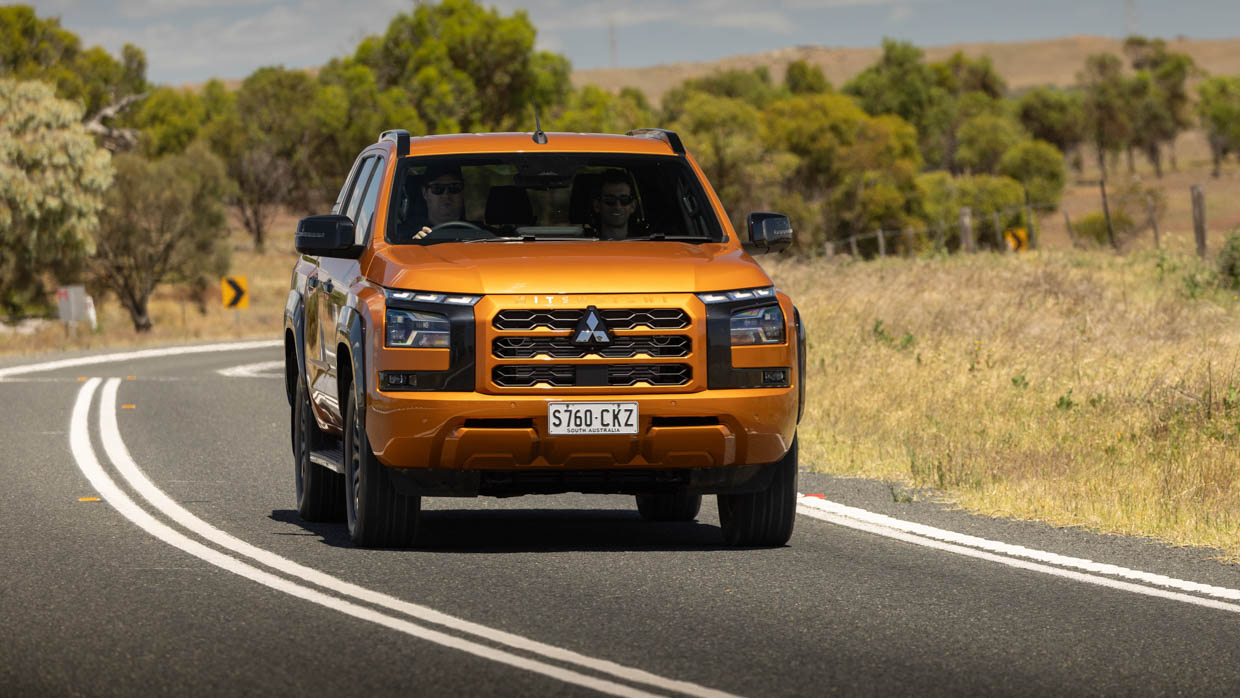
Other notable inclusions are the front-centre airbag, front and rear cross-traffic alert systems along with front and rear parking sensors – all as standard. Other features include:
However, in yet another example of well-meaning ideas failing to achieve their purpose due to over-zealous implementation, it must be noted that the driver monitoring system is absolutely horrendous.
Sitting on top of the steering wheel column (and partially blocking the driver’s via of their in-gauge display) the sensor keeping an eye on the driver is very, very easy to trigger.
The positioning of the sensor and the complete lack of tolerance for any temporary blockage between it and the driver, immediately results in a ‘bong’ notifying the driver that the driver monitoring system is no longer in operation.
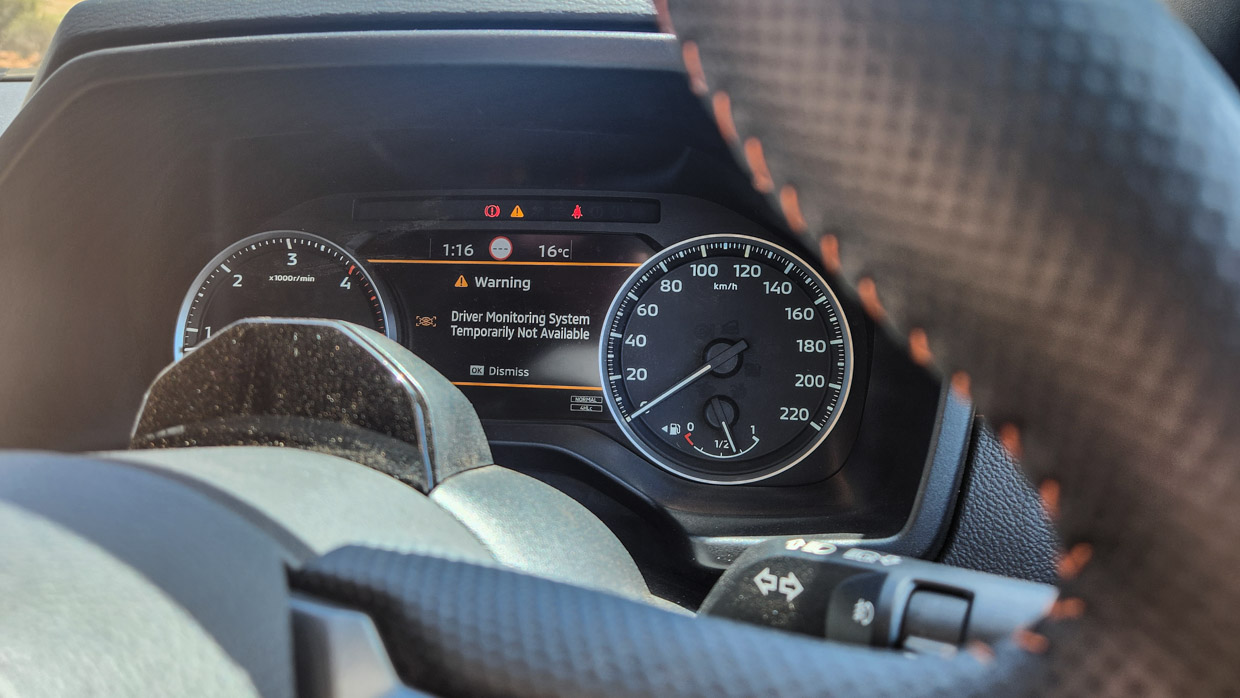
Such a ‘blockage’ was actually just my hand positioned at 12 o’clock, as is often the case when parking. This allows my right hand to work the wheel from a high point of leverage, while my left operates the shifter.
While every driving instructor will generally tell you to keep your hands at nine and three, this isn’t always relevant at low speeds, and I was constantly pestered by this system due to my hand blocking the sensor, including – astonishingly – when driving off-road in low-range 4×4.
Even when the sensor was left with a clear line of sight however, the troubles continued, with basic actions such as looking at my gauges or checking the rear-view mirror resulting in an auditory penalty.
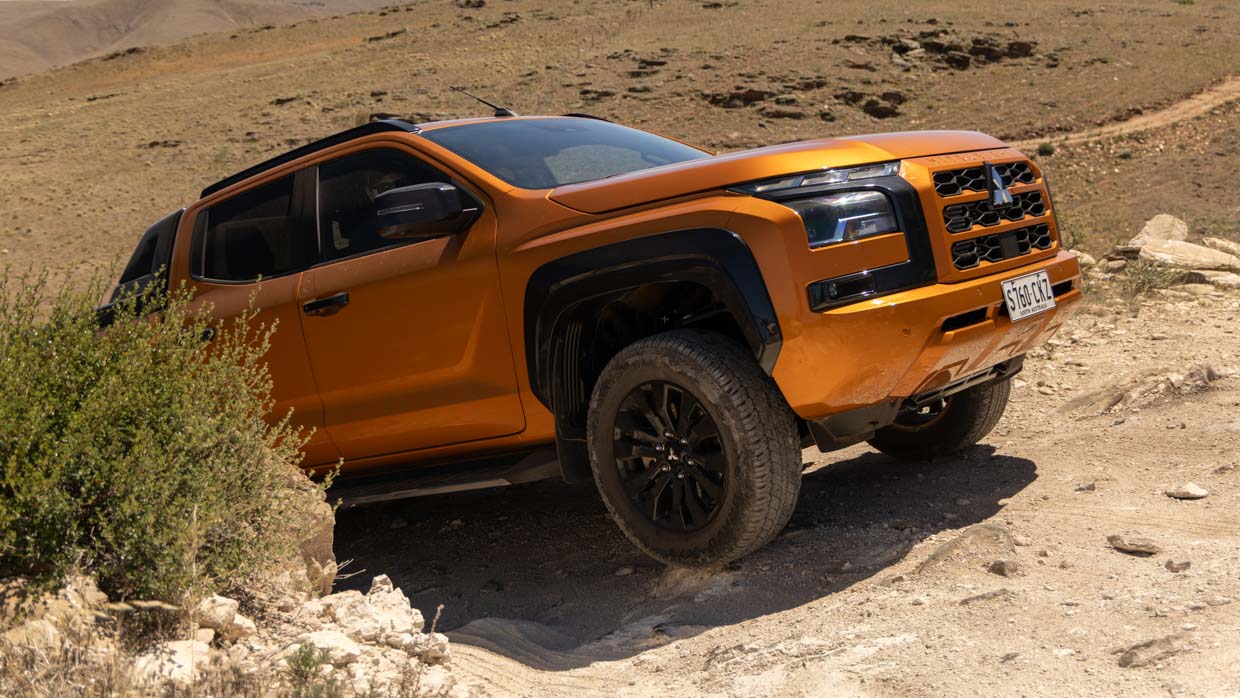
The system returns every time you start the Triton, as per ANCAP’s requirements, though mercifully, turning it off is a quick process.
We’re told the system is vital for the Triton to achieve five-stars under ANCAP’s current protocols and it’s unclear how much is down to poor implementation….. or clumsy guidelines set by the safety institution.
Previously, we’ve been equally irritated by variations of this system on the GWM Tank 300 Hybrid 4WD SUV and the Cherry Tiggo Pro 7 midsize SUV, to name two.
Ultimately, if ANCAP fails to note in its report how ineffective and ultimately distracting this feature is in practice, as well as provide manufacturers with better guidelines for future implementation, the Triton might as well play TikTok videos within the gauge cluster. The effect on the driver is, ultimately, the same.
Being a Mitsubshi, the Triton is eligible for the brand’s 10-year/200,000km warranty, which is initially limited to five-years/100,000kms but extended if you keep going back to the brand’s official dealership network.
Service intervals are every 15,000kms or 12 months, which beats the pants of a Hilux (six months/10,000kms) but really most utes in this class provide about this much flexibility.

As part of the brand’s 10-year warranty it also offers up to 10-years of capped price servicing, which has actually dropped from $6740 with the old Triton to $6690 for the new model. It might only be $50 extra in your pocket, but it’s heading in the right direction.
These rates aren’t the cheapest in the segment but if you’re on a budget or looking to retire with on a fixed income, knowing what your ute is going to cost to service all the way until 2033 is pretty incredible, and by then I think those prices will seem a whole lot friendlier.
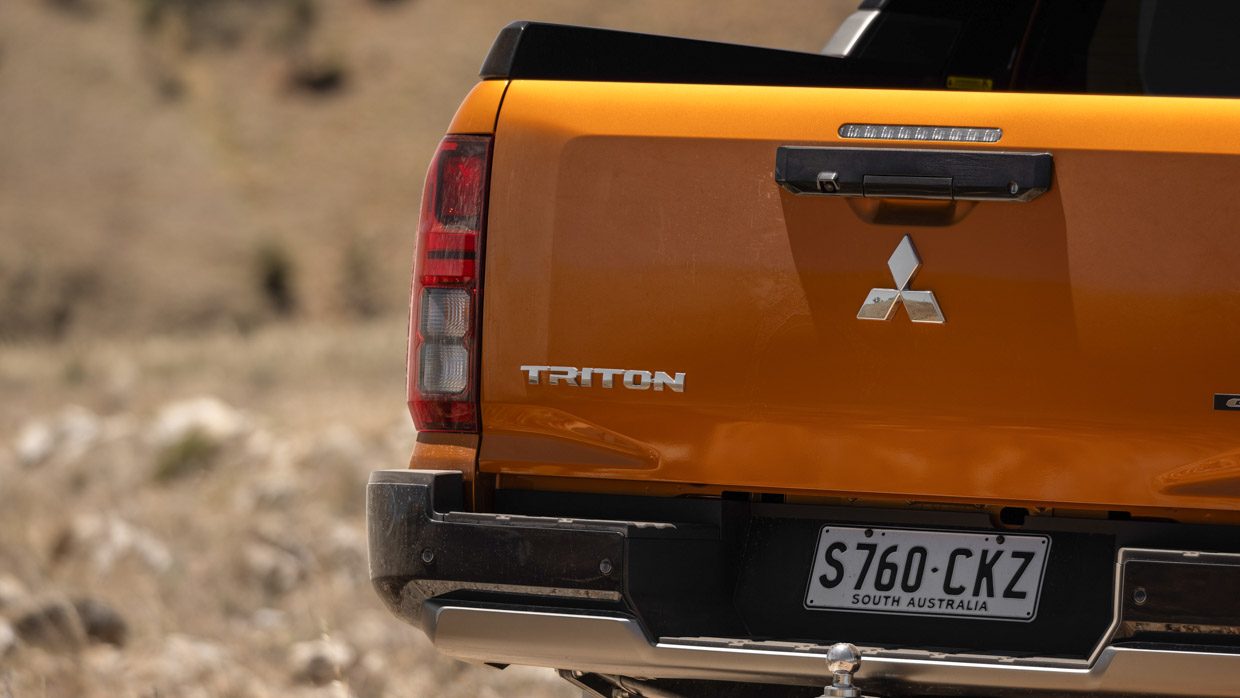
In terms of fuel efficiency, the 10 percent bump in power has also come with a 10 percent increase in fuel efficiency, with automatic-equipped 4×4 dual-cab pickup models now sporting a combined 7.7L/100km figure – down from 8.4L/100km in the old Triton.
That figure gets down to 7.5L/100km for the 4×2 GLX and we’re yet to see the figures for the six-speed manual, single-cab or cab-chassis versions.
So much points to a much fitter Triton in this sixth generation, even if many welcome improvements essentially help it measure up more confidently with established competitors.
The Isuzu D-Max was really the first to kick off a new generation of safer, more comfortable and all-round better utes in 2020.
Following soon after was its Mazda BT-50 clone, and Ford and Volkswagen’s one-two punch with their respective Ranger and Amarok models, which have once again elevated the segment in which they sit.

These vehicles aim for lengthy lifecycles without risk of short-term technical redundancies, so it’s important that they are competitive right off the bat and that they can face the heat from emerging competition for years to come.
Given its past performance, the Triton became something of an ‘also-ran’ for the ute segment. But with its heightened capabilities and somewhat unique price point carved between its Chinese rivals and pricier industry leaders, this is a ute nameplate that has once again managed to carve out a niche of its own.
It’s also a huge vote of confidence for the incoming Pajero Sport in 2025, which is expected to be based on the Triton ute twin, as it was before.
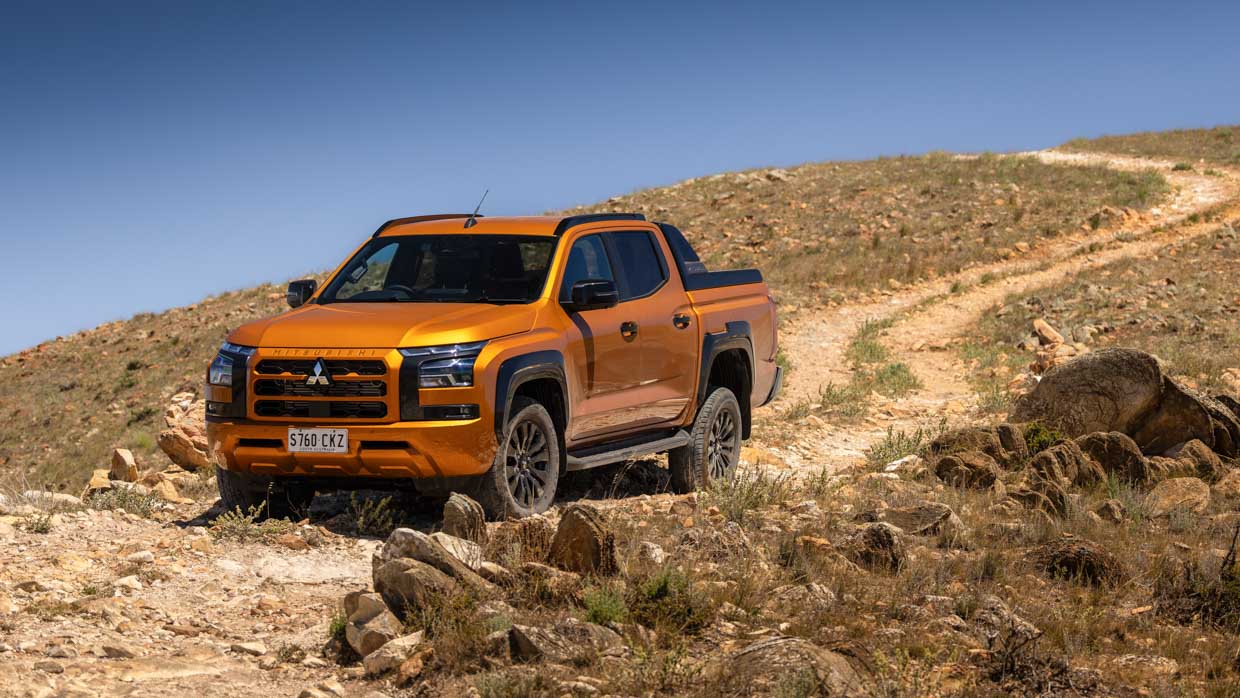
And with talk of potential high-performance variants along with hybrid, plug-in hybrid and even fully electric drivetrains, we may yet see an even better version come along yet.
More testing is needed back at Chasing Cars HQ to determine its standing among its rivals, but the fundamentals, as they stand, are strong for the sixth-generation Triton.
So all of this considered, what is our verdict? With a nod to the spin doctors, consider me frightened.
Key specs (as tested)
About Chasing cars
Chasing Cars reviews are 100% independent.
Because we are powered by Budget Direct Insurance, we don’t receive advertising or sales revenue from car manufacturers.
We’re truly independent – giving you Australia’s best car reviews.
The estimate provided does not take into account your personal circumstances but is intended to give a general indication of the cost of insurance, in order to obtain a complete quote, please visit www.budgetdirect.com.au. Estimate includes 15%^ online discount.
^Conditions Apply
Budget Direct Insurance arranged by Auto & General Services Pty Ltd ACN 003 617 909(AGS) AFSL 241 411, for and on behalf of the insurer, Auto & General Insurance Company Limited(ABN 42 111 586 353, AFSL 285 571).Because we don’t know your financial needs, we can’t advise you if this insurance will suit you. You should consider your needs and the Product Disclosure Statement before making a decision to buy insurance. Terms and conditions apply.
Indicative quote based on assumptions including postcode , 40 year old male with no offences, licence suspensions or claims in the last 5 years, a NCD Rating 1 and no younger drivers listed. White car, driven up to 10,000kms a year, unfinanced, with no modifications, factory options and/or non-standard accessories, private use only and garaged at night.
^Online Discounts Terms & Conditions
1. Discounts apply to the premium paid for a new Budget Direct Gold Comprehensive Car Insurance, Third Party Property Only or Third Party Property, Fire & Theft Insurance policy initiated online on or after 29 March 2017. Discounts do not apply to optional Roadside Assistance.
2. Discounts do not apply to any renewal offer of insurance.
3. Discounts only apply to the insurance portion of the premium. Discounts are applied before government charges, taxes, levies and fees, including instalment processing fees (as applicable). The full extent of discounts may therefore be impacted.
4. We reserve the right to change the offer without notice.